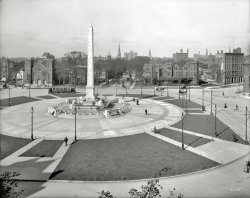
MAY CONTAIN NUTS

Search Shorpy
SHORPY ART

Framed or unframed, desk size to sofa size, printed by us in Arizona and Alabama since 2007. Explore now.
Join and Share
Ad-Free Shorpy
Shorpy is funded by you. Patreon contributors get an ad-free experience.
Learn more.

Recent comments
- Baldwin 62303
- Baldwin VO-1000
- Cold
- No expense spared
- Tough Guys
- Lost in Toyland
- And without gloves
- If I were a blindfolded time traveler
- Smoke Consumer Also Cooks
- Oh that stove!
- Possibly still there?
- What?!?
- $100 Reward
- Freeze Frame
- Texas Flyer wanted
- Just a Year Too Soon
- WWII -- Replacing men with women at the railroad crossing.
- Yes, Icing
- You kids drive me nuts!
- NOT An Easy Job
- I wonder
- Just add window boxes
- Icing Platform?
- Indiana Harbor Belt abides
- Freezing haze
- Corrections (for those who care)
- C&NW at Nelson
- Fallen Flags
- A dangerous job made worse
- Water Stop
Member Photos
The Shorpy
Print Emporium
Print Emporium
Search Shorpy
Search results -- 30 results per page
- Buffalo: 1900
- Circa 1900. "Buffalo, New York. Creek and elevators near foot of Main Street." Detroit Publishing Company ... Posted by Dave - 07/22/2012 - 10:38am -
![Buffalo: 1900 Circa 1900. "Buffalo, New York. Creek and elevators near foot of Main Street." Detroit Publishing Company glass negative. View full size.
Snow vs. PaperHow did those buildings that look like they're covered in paper survive the brutal winters that Buffalo is famous for?
[Those are the grain elevators mentioned in the caption. - Dave]
Buffalo wingsRight above Erie Railroad car 44176 looks to be a Free Chicken!
What a layout!I swear it's a model railroad masterpiece.
I love this oneI've had this up on my screen for a long time. I long to walk through this city at this particular time and place. Chances are little of what we see here remains.
Wow The only remaining structures that I can ID would be County Hall, the Ellicott Square building and a couple of churches. Check out the Watson Elevator standing to the left. That's a 23 foot deep turning basin now. The detail level is outstanding, thanks man!
-B in B
Buffalo elevatorsIn the next three decades, milling would continue to grow as an industry in Buffalo. In 1930 it would take the title from Minneapolis as the world's largest miller.
Life Long BuffalonianWish you could see all these wonderful buildings today. People come from all over the world to see Buffalo's Architecture. I am presently working just around the corner from the Ellicott Square Building which when completed was the largest office building in the country. The other buildings B in B mentions below are even more spectacular! Buffalo has unearthed the very beginning of the Erie Canal which is somewhere in this photo. It is now part of our waterfront park as a tourist attraction.
William James on Buffalo"We had passed great smoky Buffalo in the raw vernal dawn – with a vision, for me, of curiosity, character, charm, whatever it might be, too needfully sacrificed, opportunity perhaps forever missed…"
-- The American Scene, p. 477
This photo pretty much sums it up.
Somewhere in there. . .is my grandfather, age 11. Thanks for posting this.
More detail I also did notice the Old Post Office's (now ECC) tower to the right between the Marine Legs of the paper covered elevator.
If you look close you can see a DL&W passenger train between the buildings across the crick, pulled into the original passenger station's platforms. That is now the old parking lot for the Naval Park, under the Skyway.
The Erie Canal Commercial Slip the previous poster mentioned is located just behind the white freighter docked at the terminal along the river.
Trains in the streetsI love the trains running right through the streets. As a lifelong Buffalonian, I would love to go back and live in this time for a week -- maybe around the time of the Pan American Expo.
1894 Buffalo AtlasThe map from the 1894 Buffalo Atlas depicting the foreground and buildings directly across the Buffalo River is here.
What is interesting about this is that the two elevators on the map and should be in the foreground (Sturgis Elevator and Eastern Elevator) were demolished by 1900. The little house is the little yellow rectangle with rear extension at the end of Ganson Street and the brick building all the way at the end is the remnant of the Sturgis Elevator. I think an alternate caption for this photo should be "Demolition of the Eastern Elevator, Buffalo NY, c. 1900." You can see the guys with picks and wheelbarrows and the piles of scrap metal being towed to the rivers edge, presumably for loading on a barge. Temporary tracks have been laid to allow for the movement of the scrap, tracks that do not appear in the 1894 Buffalo Atlas.
The end of Washington Street and Wilkeson and Wells elevators are directly across the river. The Lyons Elevator is on the left.
The layout of the DL&W complex at the end of Main Street is here.
(The Gallery, Boats & Bridges, Buffalo NY, DPC, Railroads)](https://www.shorpy.com/files/images/4a06148a.thumbnail.jpg)
- Buffalo Bank: 1908
- Bustling Buffalo, New York, circa 1908. "Erie County Savings Bank, Niagara Street." Another view of ... Posted by Dave - 07/22/2012 - 10:39am -
![Buffalo Bank: 1908 Bustling Buffalo, New York, circa 1908. "Erie County Savings Bank, Niagara Street." Another view of the imposing edifice previously seen here. 8x10 inch dry plate glass negative, Detroit Publishing Company. View full size.
I don't know, but --I think buildings can be both hideous and delightful, at the same time.
Harry Potter's other school?I swear this looks like it should be a school of magic! What a GREAT building!
The entire scene is cool. I love all of the business names painted on the windows and the detailing. The spires are simply amazing.
Fare to Niagara and backFifty cents roundtrip! Last time I went to Niagara from Buffalo my niggardly tip was $20. I forget the fare. Inflation has come a long, long way.
What were the Yellow Cars?
With a name like Hazard . . . This time, Frank Williams has an officemate -- Willet E. Hazard. Corporate attorney Hazard and his brothers would incorporate a gasoline motor manufacturing company in 1909. First named Hazard Engineering Co., it would soon become Hazard Motor Manufacturing Co. The slogan in a 1912 ad in "The Rudder," a yachting magazine, claims "The 'HAZARD' is distinctly better." That is the last mention of the company to be found. Wonder why?
Awesome!That's a great shot! I love the whole scene. The building is intense, why don't they make them like that anymore?
What in the worldAre those little square things under the Swift's billboard?
[An electric sign. Just wait till dark! - Dave]
Looks like rainI count at least five gents carrying umbrellas.
Erie Bank - This Is Your Lifehttp://www.buffaloah.com/h/eriebank/index.html
I'm just one guyBut that hideous thing looks like a Kremlin prison to me.
A Shorpy stapleThe last charabanc we saw was here. A kind of open-air omnibus.
Death by BuffaloMark Twain once said, "To commit suicide in Buffalo is redundant."
Or words to that effect. But it looks full of life to me! Love the long street view, and all the wonderful signage.
The obelisk next doorAnyone know what the white monument is for down the street?
Seven LampsWhen the term "architecture" is used, this is the type of structure they are referring too. Anything else is just another building.
"To commit suicide in Buffalo is redundant"That was a quip by Neil Simon, used in "A Chorus Line."
OmnibusesJust checked out the previous photo of the same bank. There are two omnibuses in front, one like that seen in this pic (probably electric; right-hand drive, too) and the other, just nosing into the lower left corner, is definitely gasoline-powered if that hood is any indicator. So I guess these things were pretty common.
Imagine Winter!This same scene would be filled with Horse Drawn Sleighs...what a fun way to get around!
No WordsI don't know what to say other than that is one of the most beautiful buildings I have seen on Shorpy. The thought of the wrecking ball plowing through those gorgeous granite walls makes me want to cry like a baby.
Charabancs!Here's why I love this site. I never heard of a "charabanc" until Shorpy. I just thought they were funny little buses. You can read all about it at http://en.wikipedia.org/wiki/Charabanc
The obeliskis the McKinley Monument in Niagara Square.
Pay your dimeand climb up to the top of the tower and choke to death on the emissions of that nearby smokestack. A testimony to the air quality of the time is that the upper floors of all the buildings are blackened with soot.
It's an electric signProbably a static illuminated letter board, vs. the Times Square style "crawl" which I think was beyond the technology of the day (though not TOO far beyond).
The bulbs aren't really bright enough to work well in daylight.
The message may have changed nightly, each letter was controlled by a large rotary wafer switch housed in a wooden box, that when turned would cause the bulbs in the sign to display a different letter at each position.
High technology, 1908 style.
Shorpy, keep these images coming, I love poring over them. America near its peak as the industrial power of the world, with no end in sight. The age of coal, steam and steel.
Weird coatThere's a man on the right side of the street, to the left of the cigar store awning, his back to the camera. What are all those white things hanging off the back of his coat? And is he holding a banjo in his right hand?
[Those are scratches and blotches in the emulsion. - Dave]
Nothing remainsEssentially everything in this image except the McKinley Monument was destroyed in "urban renewal" in the 1960s. The site of the bank now appears to be a boring late-Sixties state office building. I can't find any trace of any other original building in this image.
There was a good story written in 1967 when the Erie County Savings Bank was demolished.
(The Gallery, Buffalo NY, DPC, Streetcars)](https://www.shorpy.com/files/images/4a22504a.thumbnail.jpg)
- Expert Truss Fitting: 1900
- "Main Street, Buffalo, N.Y., circa 1900." The merchants of Buffalo, aside from making that ... Lockport was and is a neat little city in NW central New York State where canal boats travel down a series of locks. It's fun to watch. ... Posted by Dave - 07/26/2012 - 12:35pm -
![Expert Truss Fitting: 1900 "Main Street, Buffalo, N.Y., circa 1900." The merchants of Buffalo, aside from making that fine city a haven for the herniated, also offered a wide range of "deformity appliances." Detroit Publishing Co. glass negative. View full size.
Fireproof indeed!The fireproof tiles on the roof of the Iroquois were a big selling point after the horrific fire that destroyed the Richmond Hotel, which stood on the same site until 1887.
Mirror Writing?The reverse lettering above the motorman's head looks like the back of a glass sign that says SMOKING ENTRANCE REAR SEATS ONLY, whatever that means exactly.
[The signs says "Smoking on three rear seats only." - Dave]
Safe CityThat is one safety-conscious city. Note the pedestrian catcher mounted on the front of the trolley.
Niagara Falls!!!!Niagara Falls!
"Slowly I turned...step by step...inch by inch..."
From the Three Stooges short "Gents Without Cents"
Oh MyWhat a picture. This is definitely a downtown scene. I am curious about the rides to Lockport, Lewiston and Queenston. Are they entrance cities to Canada? Perhaps they are tourist destinations like Niagara Falls. This photo will take a while to gather it all and to understand Buffalo as a major U.S. city at the time.
[Those cities were excursion destinations. - Dave]
Shuffle off to Buffalo...So much detail to take in.
Wonder what a "Deformity Appliance" is.
[I am thinking something along the lines of a super-dangerous cake mixer. - Dave]
Bustling BuffaloNothing is more depressing than seeing the once-bustling major city that is now Buffalo. Interesting that the streetcar was the main mode of public transportation, and yet the newer "metro" line (consisting of one short rail from HSBC to the University of Buffalo) has contributed to the death of downtown.
Martha!And "I Love Lucy."
Your neighbor the sign painterBesides the five (or six or seven) signs of his own, Mr. Scott seems to have painted all the other signs on that building. I wonder if he traded signs for trolly rides, cigars, or deformity appliances.
Trolleys Then and NowThe open-seat single-truck trolleys seen in this picture (with smoking allowed in the three rear seats only) have long been absent from the City of Buffalo. The line is now the Niagara Frontier Transportation Authority's Buffalo Metro Rail light rail line. Interesting that the tracks on Main Street have survived, while those on Church Street, and all of the surrounding buildings, including the Iroquois Hotel, have all vanished.
View Larger Map
No heritage hereSo, is this was were the Main Street Mall now resides? Seems all these blocks were demolished. The Iroquois Hotel was torn down in 1940.
The Perfect VignetteWhat a great photo! The "Signs" signs, the omnipresent hats, the fancy streetlight. I love the advertisement for the "tobacconist"--that would make a catchy little business card, I think. Some people are dentists, some are salespeople, and then there are the tobacconists. And I wonder what got thrown into the wires crossing the street?
I also love the trolleys in the picture--somehow, my daily bus ride doesn't seem quite as cool as this. One question. What is the net in front for? I would guess it's for luggage or large packages?
[The net would be for inattentive or careless pedestrians. - Dave]
LockportLockport was and is a neat little city in NW central New York State where canal boats travel down a series of locks. It's fun to watch. The city is also the home of an American standard in every kitchen: Jell-O!
Cars?Sign says "cars leave every 15 minutes"...I don't see any cars, it's 1900 (or so) What do they mean by "cars"?
[Streetcars. - Dave]
The GlobeSure would like to be able to see more detail on that globe painted on the left side - looks like the continents have been anthropomorphized into pinup gals.
BuffaloCool! I stayed a night in Buffalo early last month. Had it still been standing, I would have chosen the Iroquois over the Holiday Inn for sure. Looks like a fun city, but you've never seen anything more depressing than Niagara Falls (the town) in winter.
You Are HereIn response to the many requests seen in comments for a time machine: here you are. Absolutely fantastic picture.
Pan-American ExpoThat's the logo for the 1901 Pan-American Exposition, held in Buffalo -- where President McKinley was shot and later died.
Trolly carsThey mean Trolly cars.
[Or maybe trolley cars. ("Cars" = streetcars.) - Dave]
Look out above!The top three floors of the Iroquois were "superadded" for the 1901 Pan-American Exposition. In 1923, owner Ellsworth Statler opened another hotel, and the Iroquois became the Gerrans Office Building. The building with the tower was transformed into one of the earliest movie theaters, the Strand.
Steve Miller
Someplace near the crossroads of America
Leroy not LockportLeroy is the home of Jell-O, not Lockport! Visit the jello museum in Leroy to learn more about the product invented by a man named Pearl.
CSI: BuffaloNice Cigar Store Indian on the right.
Oh that logo
The Pan-American Exposition Company chose Raphael Beck's design from over 400 entries, awarded him $100. They copyrighted it as the official logo in 1899. At first the design was to be used only for "dignified purposes," but due to its popularity, the decision was made to license its use. The logo was soon available on souvenirs of every conceivable description and was plastered on "everything that didn't move and some things that did." Some unscrupulous vendors ignored the licensing process and sold unofficial souvenirs with the logo. Here is a plate and a watch souvenir (both official):
Beck made sketches of President McKinley when the president toured the fair and made a speech there. After McKinley died Beck completed the painting titled "President McKinley Delivering His Last Great Speech at the Pan-American Exposition, Sept. 5, 1901."
Beck went on to design the logo for the 1905 Portland, Oregon Lewis and Clark Centennial Exposition. His father Augustus—who designed the bas relief at the base of the Washington Monument—named his son after the famous painter Raphael.
+122Below is the same view from September of 2022.
(The Gallery, Buffalo NY, DPC, Streetcars)](https://www.shorpy.com/files/images/4a08404u.thumbnail.jpg)
- Urban Buffalo: 1904
- Buffalo, New York, circa 1904. "Main Street." Landmarks on view include the Buffalo Savings ... Posted by Dave - 05/02/2017 - 9:50am -
![Urban Buffalo: 1904 Buffalo, New York, circa 1904. "Main Street." Landmarks on view include the Buffalo Savings Bank dome and Hengerer's department store. 8x10 inch dry plate glass negative, Detroit Publishing Company. View full size.
Progressive BuffaloIt's only 1904 and already there's a store with an "AUTO SUPPLIES" sign out front and three of the newfangled machines parked at the curb.
Early Activist?The lady sitting in the chair, holding a sign, is interesting. I can make out 'Free' but that's about all.
["The Salvation Army Free Excursion [Outing?]..." -tterrace]
What People Wore in 1904It's definitely 1904; the one billboard on the side of the building just left of center announces some giveaway to be made on December 24, 1904. And since the streets are clear and the clothing moderate, it could be late summer or early Fall of that year.
I Wonder?If the Failing Optical Co. is still in business?
Buffalo Savings Bank"The Gold Dome" is still there. It's a Buffalo landmark still!
(The Gallery, Buffalo NY, DPC, Stores & Markets, Streetcars)](https://www.shorpy.com/files/images/SHORPY-4a12138a.thumbnail.jpg)
- Buffalo: 1905
- Buffalo, New York, circa 1905. "Looking up Main Street. Steamer North Land at Long ... Posted by Dave - 07/20/2012 - 7:17pm -
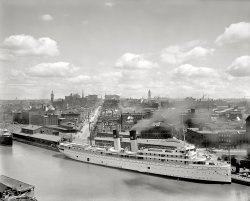
- Teeming Buffalo: 1905
- Circa 1905. "Buffalo, New York, Main Street." A bird's-eye view of Buffalo. 8x10 inch dry plate glass ... Posted by Dave - 07/22/2012 - 10:41am -
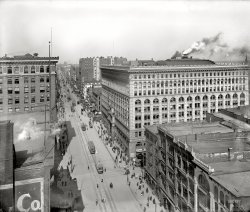
- Niagara Street: 1908
- Buffalo, New York, circa 1908. "Erie County Savings Bank, Niagara Street." 8x10 inch dry ... Posted by Dave - 06/21/2011 - 11:55am -
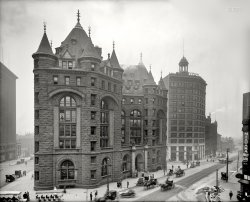
- Thruway Lanes: 1956
- ... building appears to be the Thruway Lanes in Cheektowaga, New York -- 1550 Walden Avenue. The front entrance is to a mall-like area that ... Thruway Lanes is still in Cheektowaga, N.Y. (a suburb of Buffalo, about 25 minutes from Niagara Falls). You would take exit 52W of the ... Posted by Dave - 11/21/2008 - 8:35pm -
![Thruway Lanes: 1956 Bowling alley circa 1956. Next door: Fine dining at the Thruway Restaurant. Color transparency by Dmitri Kessel, Life magazine photo archive. View full size.
ColorsAside from the subject matter - the colors in this photo are absolutely stupendous.
That Fifties FeelingLooking at this kind of place in the fifties brings back that old feeling. This was when a dollar was dollar, life was steady and predictable, and everything seemed so important and substantial. You just seemed to know your place in life and the value of things... where's my baseball cards?
An order of friesWhen I was in high school the bowling alley restaurant was the best place to go for great late-night french fries and a cup of coffee. With three or four friends you could probably spend $2. Leaving our Honda 50 scooters in the parking lot we were a wild bunch.
Fast forward to 2008...now I have a car and can go anyplace I want to, but where can I get great french fries?
Empty FishbowlI love the warm Flintstonian vibe of the bowling alley entrance, but that chamber of solitude on the left is the most depressing storefront ever.
Buffalo NYhttp://maps.google.com/maps?f=q&hl=en&geocode=&q=1550+Walden+Ave+Buffalo...
http://maps.live.com/default.aspx?v=2&FORM=LMLTCP&cp=r4j5bj8f1kp7&style=...
Maybe some Buffalonians will help ID this bowling alley.
A Hopper FeelMan, this place is hopping! It's pretty eerie.
Cheektowaga Lanes, outside BuffaloThe building appears to be the Thruway Lanes in Cheektowaga, New York -- 1550 Walden Avenue. The front entrance is to a mall-like area that leads to the bowling alley. In 1972, I worked as an Air Force recruiter in an office in that little mall area. There was also an Army recruiting office. All of us ate at the restaurant. Thruway Lanes was THE center of Cheektowaga. Anyone else have pictures of the Thruway Lanes in the 1970s?
Thruway ColorsThe colors are arresting, but I think they may owe more than a bit to the kind of red-shift fading typical of Ektachromes from this period.
Great French FriesUnfortunately you will never get great french fries again.
What made them so good was that they were fried in beef lard. The Health Nazis have taken away that particular pleasure along with many others. Smoke, drink and eat what you want and save Social Security from bankruptcy.
[You can still buy lard in just about any grocery store. So have at it. - Dave]
LardLard is from pork. Beef "lard" is tallow. I have no idea if you can buy it in grocery stores. McDonald's used to use it for their fries.
[It's next to Crisco in the shortening aisle at Costco. Think of it as spackle for the arteries. Lard is, by the way, the secret to really good pie crust. - Dave]
Lard AlmightyYes, when I worked in a bakery in the early 1990's, we used lard in our pie crusts and they were sublime. When we switched to vegetable shortening, they were still good but you had to finesse them more to get them that way.
I'm a LocalThe Thruway Lanes (as we locals call it) is now AMF Thruway Lanes. It is still there; among all the new shopping malls surrounding it you could hardly see it if you didn't know it existed.
I was just thinking about how good McDonald's fries used to be, yes they may not have been good for you but we all knew that. People are eating the new less fat ones, (which to me taste like and have the texture of sticks)!
Back in the early 70's the local FM radio station (97 ROCK) used to have a contest of the best McDonald's fries around. The franchise at Clinton & Ogden always came up the winner!
[Where's "there" -- Cheektowaga? - Dave]
Thruway Lanes cont'dOops, sorry, yes Thruway Lanes is still in Cheektowaga, N.Y. (a suburb of Buffalo, about 25 minutes from Niagara Falls). You would take exit 52W of the NYS-90 to get there.
I can clearly remember the smell of the place. Nothing like a bowling alley to bring back a lot of childhood memories. I still have friends who bowl on leagues at the Thruway Lanes!
[Thanks for the info! You know what would be great? A current photo taken from the same angle. - Dave]
LardoWhile at the local Kroger, I found that even Pillsbury commercial pie crusts are made with lard - and they proudly proclaim "No Trans Fats!" My wife is firmly in the lard camp, as well - flaky, delicious crusts every time.
Lard? Never!Aunt Chick would tell you that butter is the secret to perfect pie crusts -- of course, her non-stick rolling pin cover and pie pans wouldn't hurt, either. When I moved into my first house, I found several small cookbooks left behind, including a well-buttered copy of "Aunt Chick's Pies." My first two pies? Perfect!
http://en.wikipedia.org/wiki/Nettie_McBirney
[Still, try lard. Another really good cookbook: any 1950s edition Meta Given's Modern Encyclopedia of Cooking. - Dave]
Dream fontDoes anyone know the name of that typeface? This is a very special photograph -- just solid, but lonely and moody, too. I used to dream about places like this when I was in the Peace Corps. I wanted to be in Cleveland -- in a bowling alley. Never mind that I had never been in Cleveland nor in a bowling alley.
Way late to this partyI grew up a couple miles from Thruway Lanes. They did have good fries (crinkle cut if I remember correctly). I was closer to the Airport Lanes though, and that's where I belonged to a league.
A sad lossI'm sad to say that as of March of 2015, The Thruway Lanes is no more. The car dealer next door to them bought the building to expand, and shut them down.
(LIFE, Sports)](https://www.shorpy.com/files/images/thruway_2.thumbnail.jpg)
- Buffalo Savings: 1904
- Buffalo, New York, circa MCMIV. "Buffalo Savings Bank." Just look at the time -- I:LV -- ... Posted by Dave - 08/13/2013 - 3:56pm -
![Buffalo Savings: 1904 Buffalo, New York, circa MCMIV. "Buffalo Savings Bank." Just look at the time -- I:LV -- gotta run! 8x10 glass negative, Detroit Publishing Co. View full size.
I've got my cloakNow where is the Dagger shop?
Did the sweepers have a quota?How much territory was a street sweeper expected to cover? I think I see another sweeper by the restaurant. How did they manage to clean the streets in the winter - Buffalo can get a lot of snow? As for the letter box - my neighborhood had one until just a few years ago. The Wilkinson Building has a sign proclaiming "Wearing Apparel" - is there any other kind? I'm afraid I am still trying to interpret Dave's reading of the clock.
[I:LV = 1:55. - Dave]
Those who are tardy do not get Fruit CupI have to wonder if Nurse Diesel is standing behind one of those large arched windows and if there is a spiderweb shadow on the walls inside.
U.S. MailWhy the different mailboxes? You would think that with the most widespread form of communication (with phones a way distant second) that mailboxes would be large and all over the place.
[With letterboxes on practically every street corner, and pickups at least twice a day, they don't need to be that big. The telegraph, and telegrams, would be No. 2 for intercity communication. - Dave]
Cloak for saleOh good the store next door sells cloaks! They are hard to find. It would have been nice if a cloak wearer was seen strutting the latest in early 20th century garb. BTW was 1899 the year the building was built?
Buffalo GuysThere are 2 men in straw Boater hats standing at the curb in front of the J.M. Wilkinson & Co store. One of them appears to have jumped the gun by about 90 years and could be talking on his cell phone, while the other one seems to be blowing his nose into the street.
Don't HVIII MeI know, I am probably weird, but I have been an XIIDIGITATOR for many years as well as a fan of sniglets.
XIIDIGITATION (ksi dij i tay' shun) n. The practice of trying to determine the year a movie was made by deciphering the Roman numerals at the end of the credits.
It also works for cornerstones and grave monuments in addition to movie credits.
Ding-dingNote the two ladies posing coyly with their two-wheeled steed, behind the fire hydrant.
"I think [the bicycle] has done more to emancipate women than anything else in the world. It gives a woman a feeling of freedom and self-reliance. The moment she takes her seat she knows she can't get into harm unless she gets off her bicycle, and away she goes, the picture of free, untrammeled womanhood." So sayeth Susan B. Anthony, in 1896, er, MDCCCXCVI.
Groovy hydrantsEspecially the one on the left.
MDCCCXCICOK, I was away from school the day they taught Roman numerals, never did learn them, I never knew when any building was ever built.
Completed in 1901This still-standing Beaux Arts building was designed by the Buffalo firm of Green & Wicks. The dome was originally copper-sheathed but is now gilded with gold leaf.
Grand old building with such great detail!The striking detail on beautiful old buildings like this always amazes me! So glad this one is still standing!
(The Gallery, Bicycles, Buffalo NY, DPC)](https://www.shorpy.com/files/images/4a12140a.thumbnail.jpg)
- Buffalo P.O.: 1910
- Buffalo, New York, circa 1910. "Post Office, Ellicott Street." 8x10 inch dry plate glass ... Posted by Dave - 08/15/2012 - 2:39pm -
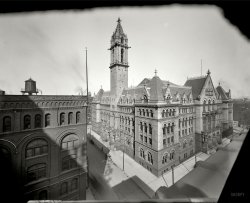
- Speed Demon: 1904
- Buffalo, New York, circa 1904. "Delaware Avenue." Hitching posts, mounting blocks, ice ... Posted by Dave - 08/10/2012 - 12:14am -
![Speed Demon: 1904 Buffalo, New York, circa 1904. "Delaware Avenue." Hitching posts, mounting blocks, ice wagons and gaslight at the dawn of the automobile age. 8x10 inch dry plate glass negative, Detroit Publishing Company. View full size.
Mark Twain and Buffalo wintersThe story of all the millionaires on this street reminds me that Mark Twain married and retired to Buffalo. After digging for gold in California, Twain became a gold digger and married into money.
I wonder what this street looked like during the next winter. How on earth did they clear the streets, or did all the millionaires go to Florida? I will always remember visiting Buffalo in May and seeing huge, melting mounds of plowed snow. Puts their winter into perspective.
I would love to be thereFinally horseback riders! I would love to ride a horse around the city streets with no cars. Nice houses too. Those people were so lucky.
Two ladies?I suspect the man is adjusting the lady's stirrup. Remember that even an ankle showing during this time was shocking, so I seriously doubt he was doing anything even slightly inappropriate.
What is truly odd is that the sorrel horse is wearing a sidesaddle as well. Men didn't ride sidesaddle. I wonder if the dark horse threw a shoe and the man was allowing the lady to ride his horse home? Or is there another lady we can't see?
[Count the legs -- there are three horses in this group. - Dave]
Clop-clopAnd the rare rider on horseback in a city.
Elm trees!And American Elms lining the street.
Even from 106 years and 2,000 miles awayI can hear those horses flipping out, and the riders screaming, "Slow down, you whippersnapper!"
Can't help but noticeThe woman riding sidesaddle. Her gentleman friend seems extra helpful.
Uh-ohI suspect that we'll soon see a Google Street View that shows this lovely tree-lined street of serenity has been replaced by one choked with automobiles, strip malls and gas stations. I hope I'm wrong.
So civilized!Wow. Such a quiet, peaceful street scene!
It's hard to imagine such a civilized world.
Time TravelI have a new favorite. Full size, zoom in, and walk back in time. Well done, Dave.
Grew up hereThank you for showing this elegant street in its prime. I grew up in Buffalo and you could always catch a hint of what once was when driving down Delaware Avenue.
Delaware AvenueIn 1901, President William McKinley was shot at the Pan American Exposition in Buffalo and brought to the home of Expo head John Milburn at 1168 Delaware Avenue. (The house was later, unbelievably, torn down and paved over for a parking lot -- with schoolchildren watching.)
When McKinley took a turn for the worse, Vice President Theodore Roosevelt made his famous dash from Mount Marcy in the Adirondacks to Buffalo -- the trail is still there today. Feeling it was inappropriate to swear in at Mr. Milburn's house, where McKinley was being autopsied, Roosevelt moved his inauguration to his friend Ansley Wilcox's mansion, a away at 641 Delaware Avenue. Today, it is the Theodore Roosevelt Inaugural National Historic Site.
VroomMust be a crazed teenage driver. I bet he has that thing up to 15, maybe 20 mph!
Oh my!I was more than a little shocked when I saw the man on the left with his hand under the skirt of the lady on the white horse. Even if it is her husband, I believe that show of affection in public was more than a little risque. I have to admit though, I do think it's very romantic.
Beautiful HomesI walk this stretch of Delaware Avenue every day at lunch. This was the address to have in Buffalo at the turn of the 20th century. I have heard it said that more millionaires lived in Buffalo than any other American city at the time.
Many of these homes are still standing but occupied by businesses. I can only imagine what it was like growing up in one of these places.
Those trees are no longer there, like the millions of others wiped out by Dutch Elm disease.
Delaware Avenue todayLooks pretty much the same.
View Larger Map
Beautiful BuffaloThank you for another gorgeous shot of beautiful Buffalo! I grew up in Buffalo and although some of this beauty is lost, we still have quite a bit.
(The Gallery, Buffalo NY, Cars, Trucks, Buses, DPC, Horses)](https://www.shorpy.com/files/images/4a12147a.thumbnail.jpg)
- Swan Street, Buffalo: 1911
- Buffalo, New York, circa 1911. "Swan Street." The motorcar gains a foothold where hooves ... Posted by Dave - 07/22/2012 - 10:41am -
![Swan Street, Buffalo: 1911 Buffalo, New York, circa 1911. "Swan Street." The motorcar gains a foothold where hooves once trod on Swan in Buffalo. 8x10 glass negative. View full size.
Elllicott Square BuildingA block up the street on the left is the Ellicott Square Building. When it was built, in 1896, it was the largest office building in the world.
Nice Truss!That's an optimistic tire patch, and it doesn't look home-made. Could it be a Patented Herniated Tire Belt?
Parking against the kerbI was always taught (in UK, and I don't think kids these days are taught it anyway) that if you are parking on a downwards slope against the kerb, then turn the wheels inwards so that if the handbrake gives then the vehicle would only roll towards (and be stopped by) the kerb. The car in the centre of the picture would roll out across the highway.
Right Hand DriveOf the cars where the steering wheel can be seen, all three have right hand drive. Surely they weren't all imported from eg. Europe? When did LHD become standard in the US?
[There was a gradual transition from a mix of left- and right-hand drive cars. - Dave]
Where's Waldo[rf]?I see Statler
Meep! Meep!Why am I imagining that Wile E. Coyote is somewhere under that great block of stone on the curb?
Anchor? Horse-hitch? Something to do with the ghostly passers-by?
TaggedThe cars have two license plates. Why izzat?
[One for New York and one for Ontario. - Dave]
VaultsI love the carriage all the way on the right. "Vaults for Silver storage. Cold Storage Vaults for furs." Not a fancy motorized vehicle but instead an old fashioned carriage with wooden wheels.
Looking at windowsOne of the ways you can tell if a building is from the 1800s or not, is if it has arch-top windows. Obviously they knew how to make flat-top windows then. The top floors of the buildings shown here have them. The 1907 hotel Statler has them entirely.
Obviously they didn't abruptly stop making them on December 31, 1899. But for the most part, you can date a surviving old brick building when it has those windows.
The building in the right foreground is a classic round-top masonry example that would have been around during the Civil War. I love it, especially the windows. (Though I'd hate to try and get a 2011 glass man to replace one of those upper panes).
Was it just fashion that made so many buildings have this look, or was there something structural all those keystones added to the masonry, which the flat top windows do not give the walls?
The Hotel Statlerbuilt in 1907 at Swan and Washington Streets was Ellsworth Statler's first hotel. Although still owned and operated by Statler, it became the Hotel Buffalo in 1923 when the new Statler at Niagara Square opened (built where the Castle Inn had stood). Hotel Buffalo was sold in the 1930s. It was closed in 1967 and demolished in 1968. The land was vacant until what is now Coca-Cola Field was built in 1988.
Tire patchWonderful tire patch. THE most important historic element in the photo.
Arched WindowsArch-top windows don't need a steel lintel to hold the masonry above them. The masonry arch itself directs the downward force of the bricks or stones above out to the side. With a flat top you need to use steel or a very hefty chunk of stone over a very narrow opening to do the same thing. Glass for an arched window isn't very difficult to get, and even the window frame itself isn't particularly complicated as long as it's a wood window (metal windows or metal-clad windows are another story). Getting glass that's bowed out, like you see in the windows around some turrets, now that's difficult.
I figure the turn of the century is about the time that steel became cheap enough and well understood enough structurally to be used for window and door lintels. It certainly saves on masonry work, because you don't need to build wood falsework to form the arch, nor do you have to cut the many bricks to fit around that arch. Unfortunately, these steel lintels need to be painted and maintained, because if they start to rust they break up the masonry around them and are a huge pain to replace.
Multiple License PlatesCars that traveled out of state were not automatically considered registered in their non-home state. We take for granded this reciprocity today.
Oftentimes you needed to acquire a temporary license plate or a permit to operate your vehicle in the state you were visiting. These license plates would differ by size, shape, and/or color to differentiate them from regularly issued plates.
Probably the owners of these vehicles worked in New York City and commuted from Ontario or vice versa. The use of multiple license plates can be found in many places including photos of New York City, with New Jersey or Connecticut license plates displayed, and in the District of Columbia with Maryland or Virginia license plates displayed.
+111Below is the same view from September of 2022.
(The Gallery, Buffalo NY, Cars, Trucks, Buses, DPC)](https://www.shorpy.com/files/images/4a25251a.thumbnail.jpg)
- Buffalo Crossing: 1908
- Circa 1908. "Main Street -- Buffalo, N.Y." Landmarks on view include Hengerer's Department Store and the ... in the future of Buffalo. His father was in the famous New York light infantry brigade at Gettysburg, and he himself started a large ... Posted by Dave - 05/10/2019 - 8:34am -
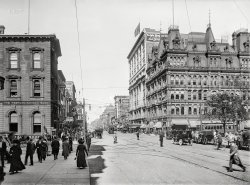
- Buffalo Rising: 1904
- Buffalo, New York, circa 1904. "St. Paul's Cathedral, Episcopal." 8x10 inch dry plate glass ... Posted by Dave - 08/14/2012 - 8:47pm -
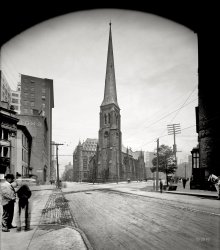
- German Band in Buffalo, New York
- ... Oktoberfest band. Bringing a taste of Bavarian music to Buffalo, New York, in 1925. View full size.
(ShorpyBlog, Member Gallery) ... Posted by phlyx - 10/30/2022 - 11:21am -
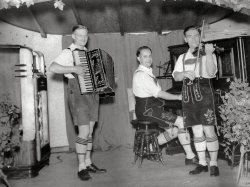
- Christmas in Buffalo: c. 1910
- Christmas with my grandparents in Buffalo, New York. They are the couple on the right. Grandmother emigrated to the U.S. in ... Posted by bhappel - 11/24/2009 - 3:25pm -
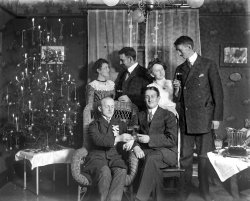
- Buffalo Trilogy: 1900
- Buffalo, New York, 1900. "Labor Day parade, Main Street." The Clairvoyant Bird Woman ... Posted by Dave - 08/15/2012 - 4:15pm -
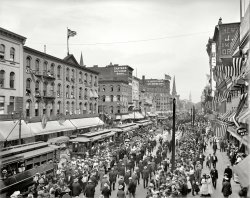
- Buffalo Boys: 1910
- February 1910. Buffalo, New York. "Home of the Palia family, 260 Terrace Street. The boy, Amorica, center, ... Posted by Dave - 10/17/2011 - 12:10pm -
![Buffalo Boys: 1910 February 1910. Buffalo, New York. "Home of the Palia family, 260 Terrace Street. The boy, Amorica, center, goes to the canning factory with his mother in summer." Photograph and caption by Lewis Wickes Hine. View full size.
Creepy Eyes!Were they dead when this was taken?
Census recordGives the family name as Paglia. Americo is about 14.
Two D ImageThere are four males in the photograph and the only one the photographer did justice to has four legs. The three humans blinked and weren't centered in the image.
However, both the dog and the door came out great.
Don't blinkLooks like the dog was the only one who was able to keep his eyes open during the exposure. There must've been some delicious people food just out of the frame on the right.
What the?It looks as if both of those boys are sporting a shiner. You have to wonder if it was from the streets or at home.
EerieThey ALL blinked!
Roughed up a bitEither there are some serious flaws with the photo, or the boy with the dog was recently involved in some kind of accident or beating. His eyes appear badly swollen, and the left one appears ready to pop out of his head. Could this have been work related?
[It's photography-related. The "zombie-eyes" effect, frequently noted on these pages, in which the subjects' eyes are recorded both open and closed in unsynchronized magnesium-flash exposures. -Dave]
It's All RelativeMaybe the boy on the right was a half-brother.
Not the best photo buteasily my favorite dog on Shorpy.
It wasn't that long ago I recall my Irish grandma stringing rope everywhere when it rained. The whole apartment was humid and smelled of laundry. But we were kids, and that was just how Grandma's house smelled. I still have a 'foam fabric' jacket with the words 'Kalamazoo Stove' melted into it in reverse. I should have taken it off before backing up to the heat!
(The Gallery, Buffalo NY, Dogs, Kitchens etc., Lewis Hine)](https://www.shorpy.com/files/images/SHORPY_00757u.thumbnail.jpg)
- Bustling Buffalo: 1900
- Circa 1900. "St. Paul's Episcopal Cathedral, Buffalo, New York." With the Guaranty (Prudential) Building and a bicycle repair shop as ... Posted by Dave - 07/01/2016 - 5:27pm -
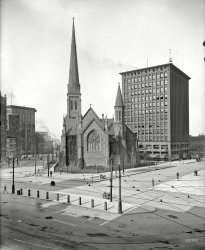
- Milwaukee of Buffalo: 1910
- Buffalo, New York, circa 1910. "Washburn-Crosby Co. flour mills." 8x10 inch dry plate glass ... Posted by Dave - 11/09/2017 - 1:40pm -
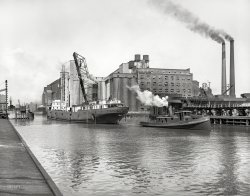
- Miami, Florida: 1908
- ... in Miami around that time.
Wild Guess Brooklyn, New York
Identity Washington Avenue, Titusville Florida.
Possible ... mustachioed Mr. Brady can be seen here .
A guess Buffalo, NY.
Found a reference to a wedding in the NY Times where Mr. and ... Posted by Dave - 10/14/2014 - 12:58pm -
![Miami, Florida: 1908 Circa 1908. Who would care to hazard a guess as to the location of this bustling metropolis? Extra points for Street View. Detroit Publishing Co. View full size.
UPDATE: The guesses as to the location of "Anytown, USA" (this post's original title) were, quite literally, all over the map -- from Deadwood to Buffalo to Whitehouse, Ohio. Many incorrect guesses for Titusville, Florida. The correct answer, and original caption: "12th Street, looking east, Miami, Florida."
Cigars, anyone?It looks like the main street of Ybor City near Tampa, Florida.
[Close, but no cigar. - Dave]
Titusville, FloridaMain Street
Titusville FloridaTitusville was the home of E.L. Brady Groceries!
GuessingI'm guessing it is Titusville.
Miami, 1200It would appear the MacArthur highway removed this locale:
View Larger Map
Location is.Titusville Florida
Titusville, FLTitusville. FL? A grocer with the same name had a building there:
I have to admit I'm not too confident; the bank building looks wrong.
Florida?Google search suggests that this may be early Miami, with E.L. Brady Groceries on right, and Frank T. Budge Hardware on the left.
Miami, FLI believe this is Miami, Florida, corner of 12th Street (now Flagler Street) and Avenue D (now Miami Avenue).
View Larger Map
I know, I know!It's the home of the Ace Novelty Company in Walla, Walla, Washington. What do I win?
Miami Map 1919This map shows Avenue D (now Miami Avenue) and 12th Street to be somewhere under the pilings for MacArthur Freeway. Too bad about the grand old house on the left a few blocks up. That shoulda been a keeper.
E.L. Brady's grocery storetells me this is Titusville, Florida.
Miami, FloridaThis is 12th Street, looking east, Miami, Florida.
Miami?A guy named E.L. Brady was a grocer in Miami around that time.
Wild GuessBrooklyn, New York
IdentityWashington Avenue, Titusville Florida.
Possible answerI cheated and Googled "E.L. Brady" grocery store" and got Titusville, FL. Did I win?
MiamiSome research indicates Flagler Street and Miami Avenue , although street view is hard to recognize.
MiamiAvenue D (now Miami Ave.) and 12th Street, Miami, Fl. It looks like it's beneath the MacAurther Causeway now.
Titusville FLA.Main Street?
Is it KC?It could be my eyes playing tricks, but I think I see a reference to Kansas City in the banner stretched across the street.
I'm guessingTitusville, Florida?
Taking a guessI think the location is somewhere in Titusville, Florida.
Titusville, Florida?Okay, here's my detective work. I Googled C.W. Schmid's Restaurant to no avail, but then I saw the E. L. Brady and Co. Groceries sign and tried that. It took me to this site, which mentions a store by the same name in Titusville. Am I right?
Brady Grocery, Titusville, Florida407 S. Washington Avenue, Titusville, Florida
"Titusville's first grocery store, L.A. Brady Grocery Store, was built in 1880. This and other buildings immediately south were occupied by Jackson Garage, Coca Cola, Bryan-Conway Realtors, Grower's Supply and Sears. The building was renovated and reopened in 1988 as the Granada Building, housing several government agencies and businesses including Gulf Atlantic Title, Cathedral Holdings and Loys Ward Surveying and Engineering."
I had not a clueBut I thought maybe somewhere up north because of the awnings, which I thought might protect from the harsh winter snow. Duh! I could not have been more wrong. Turns out they were protection from the hot sun of Florida! Having lived there for a tortuous 6 months, I should have known better.
I'm guessingTitusville,FL.
Jacksonville, Florida.It has to be Jax. There's crap in the street and it looks like a slum. Nothing has changed.
My guess is MiamiSearching for E.L. Brady's lead me to this conclusion based on this page, and this quote:
On March 3, Flagler dispatched John Sewell and twelve of his best black workers from Palm Beach to Miami to begin work on the townsite. They began by grading the site of Flagler’s hotel. (72) By late March the railroad extension had reached a point just below Arch Creek near today’s Northeast 135th Street. (73) Increasing numbers of people were coming to Miami. In order to provide them with a place to stay, Harrington and Tyler leased the Miami Hotel from Julia Tuttle — even before it had a roof over it. Located on today’s South Miami Avenue near the river, the hotel contained a dining room on the first floor and rooms on the second which only could be reached by ladder, since a staircase had not been completed. (74) A former steamboat, the Rockledge, was converted into a floating hotel by E. E. Vail, towed to Miami and docked at the foot of Avenue D (today’s Miami Avenue). (75)
Several new businesses had just opened or were about to open as March drew to a close. These included Frank Budge’s hardware store, Frank Duren’s meat market and green grocery, E.L. Brady’s grocery store, and the Lummus Brothers’ general store; additionally, a drug store, candy shop and pool room looked out over Avenue D. The lumber to build the Bank of Bay Biscayne building was being hauled to its lot next to the Brady grocery store. (76)
Survey saysI believe this is Brooklyn, NY. I took the easy way out and just searched for 1200 Avenue O from the side of the grocers wagon
Joe from LI, NY
View Larger Map
Miami?A Google search for
"e l brady" grocer 1200 ave d
turned up this link. On page 69 of which is mentioned a small grocery in Miami, run by an E.L. Brady.
A guessIs it Titusville Florida?
It's downtown MiamiThe Historical Museum of Southern Florida puts E.L. Brady Grocers, 1200 Avenue D, in Miami at that point. Avenue D is now South Miami Avenue. I'm not familiar with the area to know if the street numbering was retained.
Schmids Furniture, Whitehouse, OhioWhitehouse, Ohio? There is a reference to a "Schmids Funiture" still there in 1937 when this was written.
An updated guessIs it Miami, Florida?
MaybeTitusville, Florida?
TitusvilleStill working on the street view.
Miami, Florida?Miami, FL, 12th Street.
Anytown USA = Whitehouse OHIf you google "Schmid's Furniture" and have google uncorrect it, there's a PDF link to a report on Early Whitehouse History. In there is a reference to Schmid's Furniture on Toledo Ave (which looks very different today in Street View)
Some leadsA search for E.L. Brady's grocery brought up a couple things. This page mentions the cart part of the business, which would place this in Titusville, Florida, to the East of Orlando.
This link contains a picture of an historical marker in Titusville, which mentions that the building where Brady's grocery would have been housed in 1908 still stands, and is to the right of the sign. I'm pretty sure I've located the sign in street view here:
View Larger Map
The gardening has changed from the pictures, but the background matches up perfectly. The only step from here would be to go a few ticks over on street view and turn around, but this is where I stopped. Either I have the wrong spot or the view has changed considerably.
Found it?I found reference to E.L. Brady's grocery store which leads me to believe this is Titusville, Florida.
The building was home to E.L. Brady's grocery store. He first established his business in LaGrange, but moved to Titusville in 1886, occupying a wooden building at Main Street. The 1895 fire destroyed his store and many wood structures in the commercial district. Brady rebuilt his grocery in this building
Is this it?Not much left from 1908.
View Larger Map
No DoubtThat's downtown Anytown. (Read the heading.)
Titusville?Looks like E.L. Brady's Grocery store was located in Titusville, FL. That could be the site of this shot, perhaps...
Fort Pierce / St. Lucie, FLMan, is this a depressing indicator of change.
View Larger Map
ETA: Darn, not correct!
Miami, Fl ?http://www.hmsf.org/collections-south-florida-birth-city.htm
On March 3, Flagler dispatched John Sewell and twelve of his best black workers from Palm Beach to Miami to begin work on the townsite. They began by grading the site of Flagler’s hotel. (72) By late March the railroad extension had reached a point just below Arch Creek near today’s Northeast 135th Street. (73) Increasing numbers of people were coming to Miami. In order to provide them with a place to stay, Harrington and Tyler leased the Miami Hotel from Julia Tuttle — even before it had a roof over it. Located on today’s South Miami Avenue near the river, the hotel contained a dining room on the first floor and rooms on the second which only could be reached by ladder, since a staircase had not been completed. (74) A former steamboat, the Rockledge, was converted into a floating hotel by E. E. Vail, towed to Miami and docked at the foot of Avenue D (today’s Miami Avenue). (75)
Several new businesses had just opened or were about to open as March drew to a close. These included Frank Budge’s hardware store, Frank Duren’s meat market and green grocery, E. L. Brady’s grocery store, and the Lummus Brothers’ general store; additionally, a drug store, candy shop and pool room looked out over Avenue D. The lumber to build the Bank of Bay Biscayne building was being hauled to its lot next to the Brady grocery store. (76)
Anytown, USA is Titusville, FloridaAnytown, USA is Titusville, Florida
"E.L. Brady and Brother Grocery Store, a well established business located on Washington Ave. in downtown Titusville, put into use a delivery wagon in order to provide better customer service."
Judging by the number of wiresI would say: NYC.
Miami, Florida ...perhaps the corner of D (now Miami) and 12th Avenues?
After Titusville, FLAfter Titusville FL Mr. E.L. Brady, Grocer, moved to Miami and opened up his grocery store on Avenue D. Not sure what that is called now though.
Titusville Fla. Probably S. Washington St.
That was funThat was fun.
I was one of the Titusville people. Got it wrong. Oh well.
How about doing something like this once a week?
Not a palm tree in sightThe grocer E.L. Brady originated in Lagrange, Florida and relocated to Titusville, Florida in 1886. He would eventually became the first grocer in Miami, Florida at Ave. D and 12th Street. Today, this intersection would be Flagler Street and Miami Avenue. An interesting 1901 photo of the mustachioed Mr. Brady can be seen here.
A guessBuffalo, NY.
Found a reference to a wedding in the NY Times where Mr. and Mrs. E.L. Brady from Buffalo attended.
Brooklyn?Probably wrong, but I'll hazard a guess at Brooklyn; 1200 Avenue D is near the intersection of Flatbush, which would make that little side street on the left E. 23rd St.
View Larger Map
Is it Louisville?I think this may be Avenue D in Louisville, KY.
Miamihad an Avenue D in 1908 and a grocer called E.L. Brady.
Welcome to MiamiLooks like it's somewhere on what is now South Miami Avenue - possibly where the Route 970 overpass is now located?
FoundView Larger Map
Stop 17 on the historical walking tour.
Historical marker north of the building.
Hazarding a GuessI'm going to guess we're looking at Old Miam, South Miami Avei?
Just a GuessTitusville or Miami, FL.
Titusville, FLJust a guess.
Titusville, FLI think I see an atlas rocket taking off from the cape in the background.
Florida townI believe this is Titusville Florida.
LocationThis was taken in Miami, Florida at the corner of what is now Flagler Street and Miami Avenue. Everything in the original photo is gone, even the street names! Flagler and Miami used to be 12th Street and Avenue D, respectively.
Titusville, FloridaHome of E.L. Brady, Grocer.
Doesn't Look Like Florida to MeMy guess is Titusville FL, because that is the only place I can find a E L Brady that is a Grocer on the 1900 and 1910 census. Am I correct?
Miami, FloridaThat's my guess.
Deadwood, SD?Shot in the dark guess. Just seems very western.
Gag! I was wrong, wrong, wrong. Embarrassing since I was born and raised in Fort Lauderdale, and my grandparents + my mother moved to South Florida in 1917.
Miami, FL?Possibly Miami, as per an obituary for E.L. Brady (pulled from the "E.L. Brady and Co" store on the right, beyond the real estate agent).
That would make this shot somewhere in the vicinity of Flagler and Miami Avenue.
Miami FloridaAvenue D and 12th Street. Now Flagler Street and Miami Avenue. See if I can get a Street View.
Definitely MiamiFrom "Early Miami Through the Eyes of Youth" by William M. Straight, M.D., p.69:
"How did you get your dairy products and your groceries? Well, there were two grocery stores, little things. I think the first one was operated by a Mr. Brady, E. L. Brady, who moved here from Titusville."
On Page 63, there's mention that Avenue D is now Miami Avenue. 1200 Miami Avenue:
View Larger Map
MiamiE. L. Brady opened one of the first grocery stores in Miami, Florida. In 1908, the Bank of Bay Biscayne was located next door. I think this is the intersection of Miami Avenue and Flagler Street.
Let's see nowThere's a tag that says "Florida," but there's also a tag that says "Detroit."
Follow upFollow up to my earlier comment about E.L. Brady; according to the same obituary, E.L. Brady was an earlier settler of Titusville, FL, and started a grocery there, too.
So this could be Titusville, FL.
E. L. Brady Co. GrocersAt the corner of Avenue D and 12th Street in Miami:
Titusville, FLLooks like it's in Titusville, FL, though I'm having trouble pinning down the exact location for a Google Street View.
Halcyon HometownFinally, a shot of MY hometown, Miami!
When Miami scrapped its old street naming system in 1921, they threw out the house numbers along with the street names for the present day quadrant system.
The shot was taken on today's Flagler Street (formerly 12th Street) looking east at Miami Avenue (formerly Avenue D). The lions on the left guarded the Bank of Bay Biscayne, which stood on the northwest corner of Miami Avenue and West Flagler Street. The Halcyon Hotel, with its distinctive turrets, stood at East Flagler and 2nd Avenue (formerly 12th Street and Avenue B). It can be seen down the street on the left side.
It'd be great to see some more Old Miami shots! Thanks, Shorpy!
Let me guessI'm gonna go out on a limb here and guess that this city is in Florida?
I'm thinkingTitusville, FL
Thank you, Mr. Brady the grocerIt's Miami.
HOW COULD YOU TELL????I enlarged the photo, combed all the print details, how can you possibly recognize it a hundred years later????!!
(Thanks for the fun though.)
Bay Biscayne BankAccording to the Sanford Fire Map of 1899, the Bay Biscayne Bank was around the corner on D Avenue, on the NE side of the intersection, up the block on D Avenue slightly. Of course, it may have moved across the street to the NW corner by 1909. In the 1909 edition of Florida East Coast Homeseeker, it ran an ad noting it had moved to new digs in the Fort Dallas Bank Building; the one with the columns on the immediate left, and just west of the bank building, would have been the Biscayne Hotel in 1899. The weather bureau opened a station in the Bank of Bay Biscayne Building at that same location in 1911, so by then the building seems to have dropped the Fort Dallas appellation. The picture of the bank building provided by the NOAA website must be looking NW at it catercorner across the intersection.
(The Gallery, DPC, Florida, Miami)](https://www.shorpy.com/files/images/SHORPY-4a25100a.thumbnail.jpg)
- Eastern Elevator: 1900
- Circa 1900. "Eastern elevator, Buffalo, New York." Ship: The Frank L. Vance . 8x10 inch dry plate glass negative, ... Posted by Dave - 08/10/2012 - 12:21am -
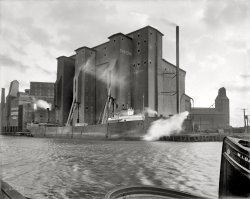
- Lafayette Square: 1905
- Buffalo, New York, circa 1905. "Lafayette Square." 8x10 inch dry plate glass negative, ... Posted by Dave - 07/22/2012 - 10:42am -
![Lafayette Square: 1905 Buffalo, New York, circa 1905. "Lafayette Square." 8x10 inch dry plate glass negative, Detroit Publishing Company. View full size.
You can't park that here! Parking next to a fire hydrant is illegal!
The Lafayette Hotelin the center of the shot in currently undergoing a $35M-$40M renovation that will result in one and two bedroom apartments and up to 50 hotel rooms, as well as several businesses on the ground floor. The exterior and much of the interior are being painstakingly restored to their original appearance. Target date for completion is May 1.
Three dimensionalThe depth of field and scope of the lens have created one of the coolest looking images yet seen. Great job of scanning to maintain the effect. I feel like I'm looking out a window onto the actual scene.
Your policy has expiredI had no intention of commenting until something struck me as humorous in the building on the right hand side. I would bet that the New York "Life Insurance" company did not appreciate one of their employees perching himself in an open fourth story window.
Plus 107and the bystanders are less ghostly and considerably less well-dressed.
View Larger Map
Good to seeThat at least two of the major buildings has survived. What was that glorious masonry gem on the far side of the Square?
[The Buffalo Public Library, dedicated 1887, demolished 1963.]
Shame
What Is It?OK, I have to ask this. Sure, I have only been on Shorpy about 3 months, but have traveled all over Europe and seen these http://www.urinal.net/pissar/
But I have never seen them in old photos such as here.
Is this a pissoir? Something for the horse buggies? Fresh water? Something for the drivers to "dispose" certain things of?
[Whatever it is, it has an electrical connection to the streetcar grid. - Dave]
*MrK replying*
I see that Dave, thanks! Missed it the first time. Also, looking at the shadow, the object looks like it does not have the same dimentions all around. Looks wide, but not deep according to the shadow.
The photo here on the page is a little too low res to discern where the wire goes or what it is connected to (Dave can you help?). I see what appears to be a fire call box on the furthest trolley pole in that block corner.
I will ask a few trolley experts here about it and hope to report back :)
Not a lot of automobiles yetbut a year later, on July 4 1906, Buffalo would record its first instance of a pedestrian being fatally mowed down by one of the infernal machines when Henry A Ward, founder of Ward's Natural Science Establishment (and taxidermist of Jumbo the Elephant mount fame) succumbed.
re: The TardisIf it is connected by wire, then so are the horses or the coachman standing close by.
No, I think the wire simply is passing above, to support another segment of the trolley cable running overhead.
[You're looking at the wrong wire. - Dave]
Formerly Courthouse SquareThis location was renamed to commemorate the Marquis de LaFayette's visit to Buffalo in 1825, the same year the Erie Canal was completed. This location is just a few blocks north of the Ellicott Square Building, designed by Daniel Burnham and opened in 1896 (the world's largest office building at the time). The Ellicott Square Building was featured on Shorpy a while back: https://www.shorpy.com/node/10750
Big GunThe large cannon at left center is a Civil War-era Parrott Rifle, named after its designer Robert Parker Parrott. These were cutting edge when introduced in 1861 and came in variety of sizes. Both the Army and Navy used them up through the early 1890s.
This particular Parrott seems to be a big one, possibly a 200 pounder, meaning it could fire a pointed shell weighing 200 pounds.
Military technology moved swiftly in the late 19th century and Parrotts were phased out as more modern artillery came into use. Many obsolete Parrotts and other Civil War cannon ended up as martial ornaments in city parks and military cemeteries.
The scrap drives of World War II took a huge toll on ornamental cannon. Wonder if this Parrott survived?
The Tardis-identity revealedThis is a police call box. Very common at the time. I've attached a picture of a rather more ornate one, but of the same general layout. I think the wire DOES go to the box, for the telephone inside.
The Tardis-identity revealedVery nice find. Makes sense now, following that wire to the fire pull box with this police call box makes sense to bundle the wires and be routed back to the same place.
Darn that Chameleon circuit, looks like it will never get fixed!
KleinhansI wonder if Kleinhans wouldn't sell their building, so they built the U-shaped New York Life building around it?
[That's an integral part of the Brisbane Building, constructed 1894-1896. The previous structure, The Arcade, was completely destroyed by fire in 1893.]
Buffalo Tardis: real identity revealedNot a call box, although many had telephone connections in a box OUTSIDE this "booth". These were used by walking patrolmen as one-man jails. A rowdy would be stuffed inside, locked up, and the paddy wagon sent for. They were at various intersections all over Buffalo, until about 1940. See photo and caption here.
Hotel LafayetteHere's an update to the previous post about the rehabilitation of the Hotel Lafayette.
I appreciate that their original 1905 sign indicated that the hotel is "Fire Proof". Sleep in safety!
As a side note, the hotel was designed an built by the first accredited female architect in the AIA, Louise Blanchard Bethune.
QuestionsTwo questions.
Where is the smoke coming from? It looks to be a warm summer day, so it wouldn't be from furnaces in the buildings. It seems to originate on top of the building between the Hotel LaFayette, and Kleinhans. Or, is it some kind of smudge on the photo plate?
[Buffalo was an industrial center with many factories as well as coal-fired locomotives and steamships. - Dave]
And, did no one ride horses in the city? Or, did no one ride horses downtown? I don't see any riders in any downtown photos, and I don't see where you'd tie one up. All I see s carriages and cars and streetcars.
[City folk didn't ride horses like they were bicycles. They took the streetcar or sidewalk (or biked) to get where they were going. - Dave]
If you go to Buffalo, do check out the renovated Hotel LaFayette. Its gorgeous!
(The Gallery, Buffalo NY, DPC, Horses, Streetcars)](https://www.shorpy.com/files/images/SHORPY_4a17410a.thumbnail.jpg)
- SuperCenter: 1941
- October 1941. "Main store for Fort Hunter, New York." Glimpsed earlier here and here . Medium format nitrate negative ... Posted by Dave - 02/28/2018 - 3:08pm -
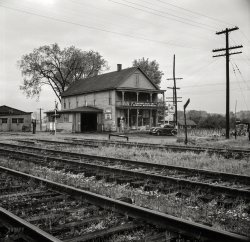
- Fellow Travelers: 1899
- Circa 1899. "R.R. depot at Garrison, New York." En route to their final destination. 8x10 glass negative, Detroit ... colonies.
B is for Buffalo The "B 390" stands for Buffalo, NY, not Boston. The New York Central did eventually reach Boston, but ... Posted by Dave - 05/18/2016 - 12:43pm -
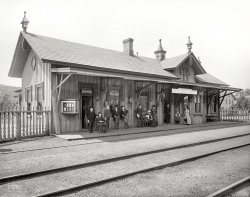
- Hydra: 1901
- Buffalo, New York, circa 1901. "Unloading ore from whaleback carrier." 8x10 inch dry plate ... Posted by Dave - 08/14/2012 - 4:27pm -
![Hydra: 1901 Buffalo, New York, circa 1901. "Unloading ore from whaleback carrier." 8x10 inch dry plate glass negative, Detroit Publishing Company. View full size.
The Limit of WoodOne can easily understand how steel construction for such machines soon supplanted wood. Notice, that despite the hefty staybolts, and cross bracing, the wood beams are seriously cracking under the strain.
Hard workPresumably, there were men down in the hold shovelling coal into the buckets. Nasty job.
Six-Rig Excelsior HoistWhat a marvelous steampunk contraption: a train of giant rolling cranes made from timbers and cast-iron gears. I can't at all understand how they are powered.
It's from an earlier generation of technology compared to the steel Brown Fast Plants pictured in A Chorus Line: 1905.
Blue Book of American Shipping, 1901
Railway Terminal Facilities for Ore
and Coal Traffic on Lake Erie
Delaware, Lackawanna & Western Railroad Co., (Docks in Erie Basin), Six-rig Excelsior hoist, built by Excelsior Iron Works Co., Cleveland; capable of unloading 2,000 gross tons in 10 hours. All rigs can be worked on vessels having hatches of 24-ft. centers or less. No Storage Room.
Interesting Ship DesignWhalebacks were Great Lakes freighters constructed between 1887 and 1898. Only a total of 43 were made. When loaded, they rode low in the water, with only the curved top showing above the waterline. The last whaleback was retired in 1969 after a long and varied career. It has been docked as a museum ship on display in Superior, Wisconsin, since 1971.
Car GenderThose little ore cars had names--I've seen them referred to as ore jimmies and ore jennies in various railroad publications. Whatever their gender, the name is always lower-case. These cars carried just as much weight as a larger coal hopper, but are smaller because the equivalent weight of iron ore takes up less room due to its density.
LighthouseThat's also one very unique and beautiful lighthouse in the background.
Still, they are a wonder to meNo, so many times I can not gather what they do exactly or understand how they work. But, somehow, I find it all so wonderful. Thanks so much.
Buffalo Main LighthouseThe lighthouse in the background is Buffalo Main dating to 1819.
The man behind the curtain Where is the operator? In the tower at the far end of Hydra?
I would love to see more pictures of this hoist if you can find them.
"AIR BRA"An ad for an air bra avant-la-lettre?
Could have been an ore jennie ;-)
After all I better vote for a "railway air brake:"
All wood and amazing.I'm struck by something this large relying on timbers for strength. It is easy to imagine much creaking and groaning during operation.
More Bang for your PhotoWow, this shot has quite the juxtaposition of the historic! The rail cars are at the beginning of air brakes and the MacDougal whaleback steamer is at the end of their production. The unloading machines days are numbered (frankly, I’ve never seen this type) however the Buffalo light house that was built in 1833 is still there.
[The "beginning of air brakes" was 30 years before this picture was taken. - Dave]
Lighthouse! The lighthouse survives! It's surrounded by a Coast Guard base, soon to become a public park.
(The Gallery, Boats & Bridges, Buffalo NY, DPC, Railroads)](https://www.shorpy.com/files/images/4a07185a.thumbnail.jpg)
- The Springwater Bunch: 1910
- ... negatives from Floyd Ingraham, who lived in Springwater, New York. I know nothing about who's here or why they were gathered in someone's ... Posted by Fredric Falcon - 08/06/2022 - 10:38pm -
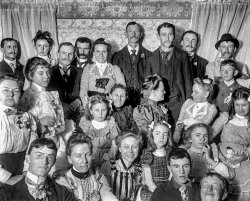
- Tin and Bones: 1920
- ... for the "long chassis". Atterbury trucks were built in Buffalo, New York.
Let Our Experts Help Your local distributor (from the San ... Posted by Dave - 05/13/2015 - 4:18am -
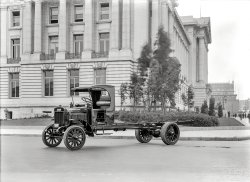
- A Penny a Pound: 1910
- March 1910. Buffalo, New York. "Antonio Martina, 53 Carolina Street. 11 years old last summer. Attends ... Posted by Dave - 06/28/2012 - 8:54pm -
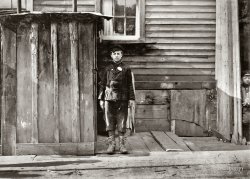
- Circle in the Square: 1908
- Buffalo, New York, circa 1908. "McKinley Monument, Niagara Square." 8x10 inch dry plate ... Posted by Dave - 07/22/2012 - 10:40am -
